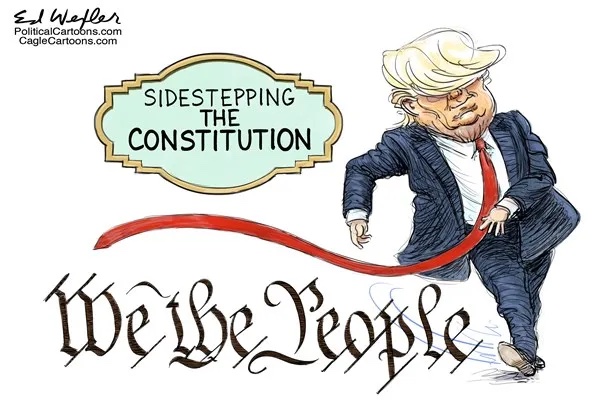National emergencies used to mean something serious: war, natural disasters, a financial meltdown.
But in the hands of Donald Trump?
A “national emergency” just means he didn’t get his way.
Over his time in power, Trump declared eight national emergencies — more than any other recent president over a similar time span. Not because the nation was collapsing (well, not until he started working on it), but because emergencies are the fastest way to bypass Congress and grab even more unchecked executive power.
Case in Point: IEPA and the Penguin Tariffs
One of Trump’s most absurd abuses came through the International Emergency Economic Powers Act (IEEPA) — a law originally passed in 1977 to give the president limited authority to deal with real threats from abroad: rogue states, terrorists, arms dealers. It was supposed to be the national security equivalent of “break glass in case of emergency.”
Trump smashed that glass like a toddler with a baseball bat.
Instead of focusing on credible threats, he used the IEEPA to slap tariffs on anyone and anything, from China to tiny nations that barely had economies, let alone posed a threat. Rumor has it if there was an island full of penguins exporting ice cubes, Trump would’ve slapped a 25% tariff on them too.
The “Emergency” Wall
Then there was Trump’s infamous border wall emergency.
Congress refused to fund his ridiculous, impractical wall.
So what did Trump do?
He declared a national emergency — so he could divert billions of dollars from the military and disaster relief, just to satisfy his political base and pretend Mexico was footing the bill (spoiler alert: they weren’t).
It wasn’t about security. It was about spectacle.
Trump created a fake crisis to justify a fake emergency, which allowed him to build a fake wall — and every branch of government except the one holding up the Constitution just stood there.
The Supreme Court: Enablers-in-Robes
Once upon a time, the Supreme Court was supposed to act as a check on presidential overreach.
Today? They mostly act like the king’s personal legal team.
The Court’s increasingly “hands-off” approach to executive actions has effectively blessed Trump’s emergency declarations, even when they were thinly disguised political stunts.
Under the legal fig leaf of “deference to the executive,” they have allowed presidential power to expand like a balloon at a kid’s birthday party — ready to pop at the worst possible moment.
Congress: From Powerhouse to Puppet Show
Meanwhile, Congress — you know, the branch that’s actually supposed to hold the purse strings and check the president — has become little more than a rubber stamp.
A noisy, chaotic rubber stamp, sure. Lots of speeches. Lots of tweets.
But when it comes to doing anything about Trump’s abuses of emergency powers?
Crickets.
Why? Fear.
Trump’s stranglehold over the Republican Party has transformed elected officials into terrified extras in his reality show presidency — terrified to stand up, terrified to lose power, terrified to tell their base that the Constitution matters more than one man’s ego.
The Danger Beyond Trump
Here’s the kicker:
Even if Trump were gone tomorrow (and he won’t be without a fight), the system he abused is still broken.
The next autocrat — and there will be another one — can pick up right where Trump left off, declaring “emergencies” whenever democracy gets inconvenient.
We don’t have a presidency anymore.
We have a throne.
And it’s only a matter of time before someone tries to sit in it permanently.
Final Thought:
When the definition of “emergency” becomes “whatever the president says it is,”
and when Congress and the courts roll over like puppies looking for belly rubs,
it’s not just a Trump problem.
It’s a democracy problem.
And the longer we pretend it’s normal,
the closer we get to waking up in a country where every day is an “emergency” —
and freedom itself is on permanent lockdown.
by Rob C.
Art by
Get the new book “Democracy for Sale – How Corporate Greed is Corrupting Democracy and Endangering the Planet.”
Available @ AMAZON
And book sellers everywhere
